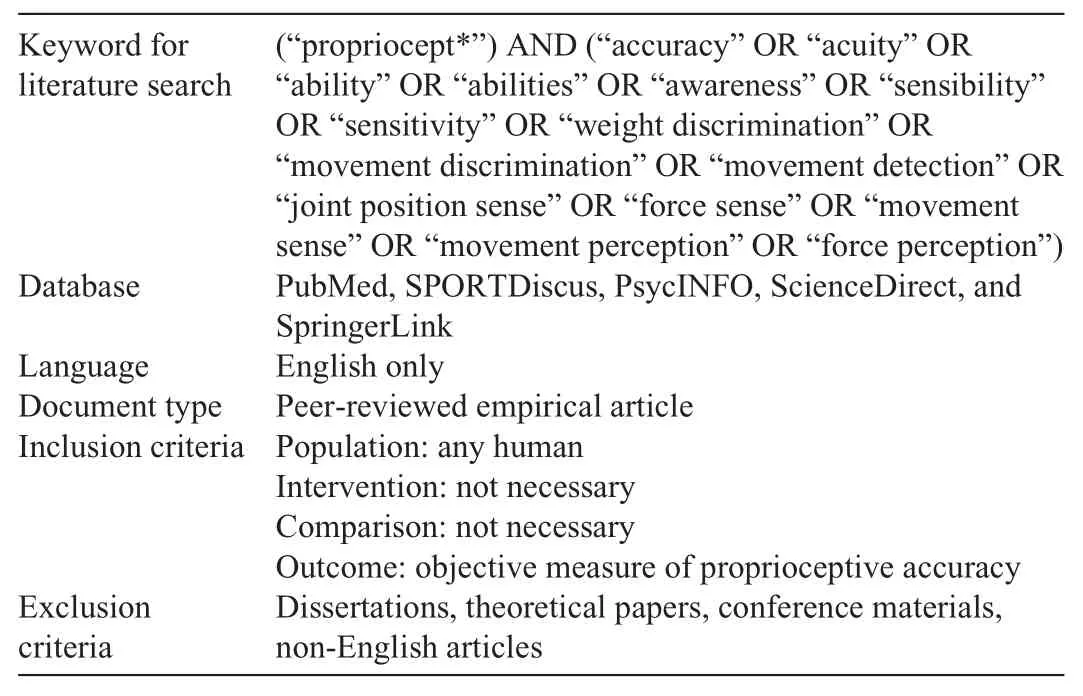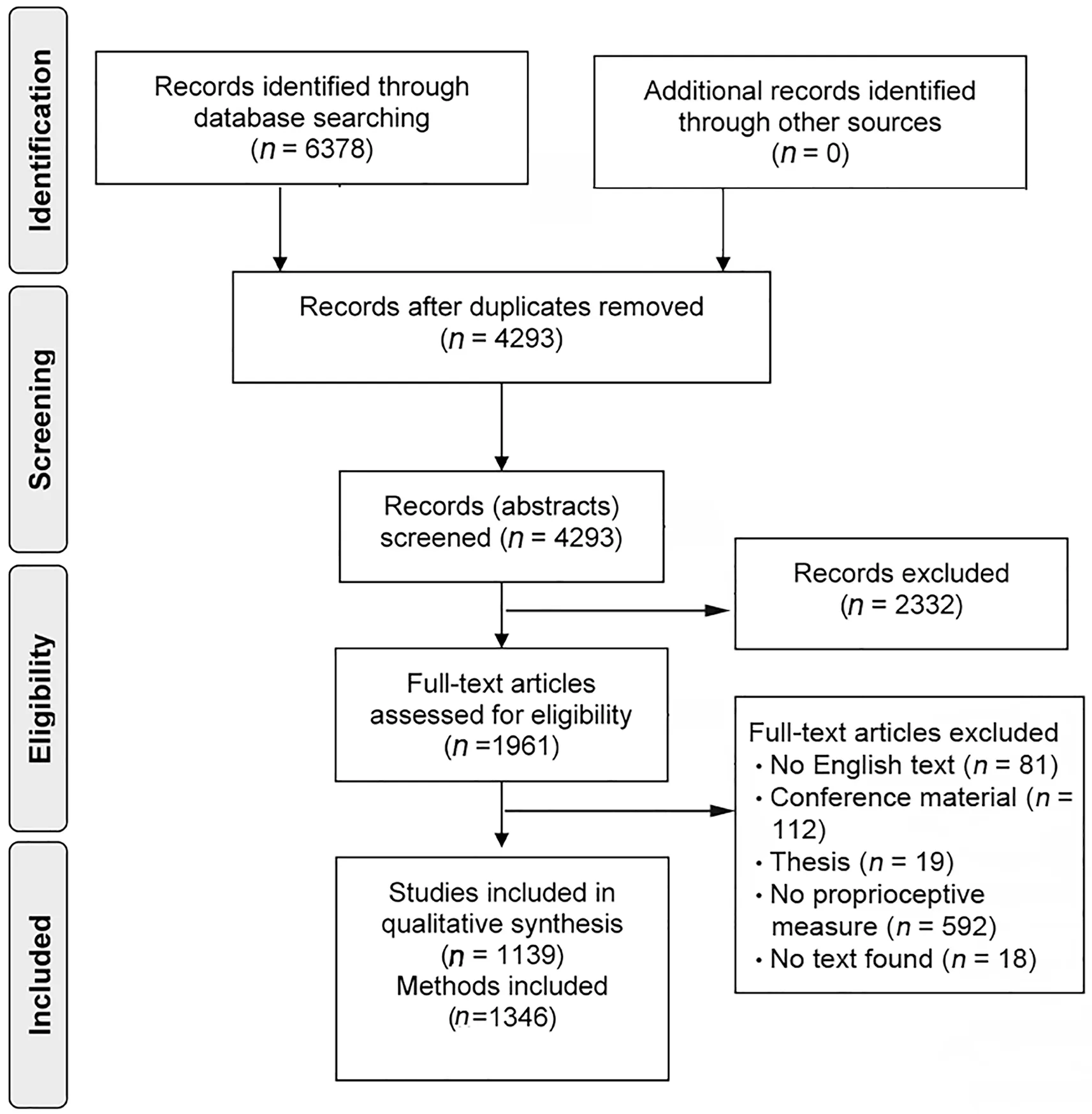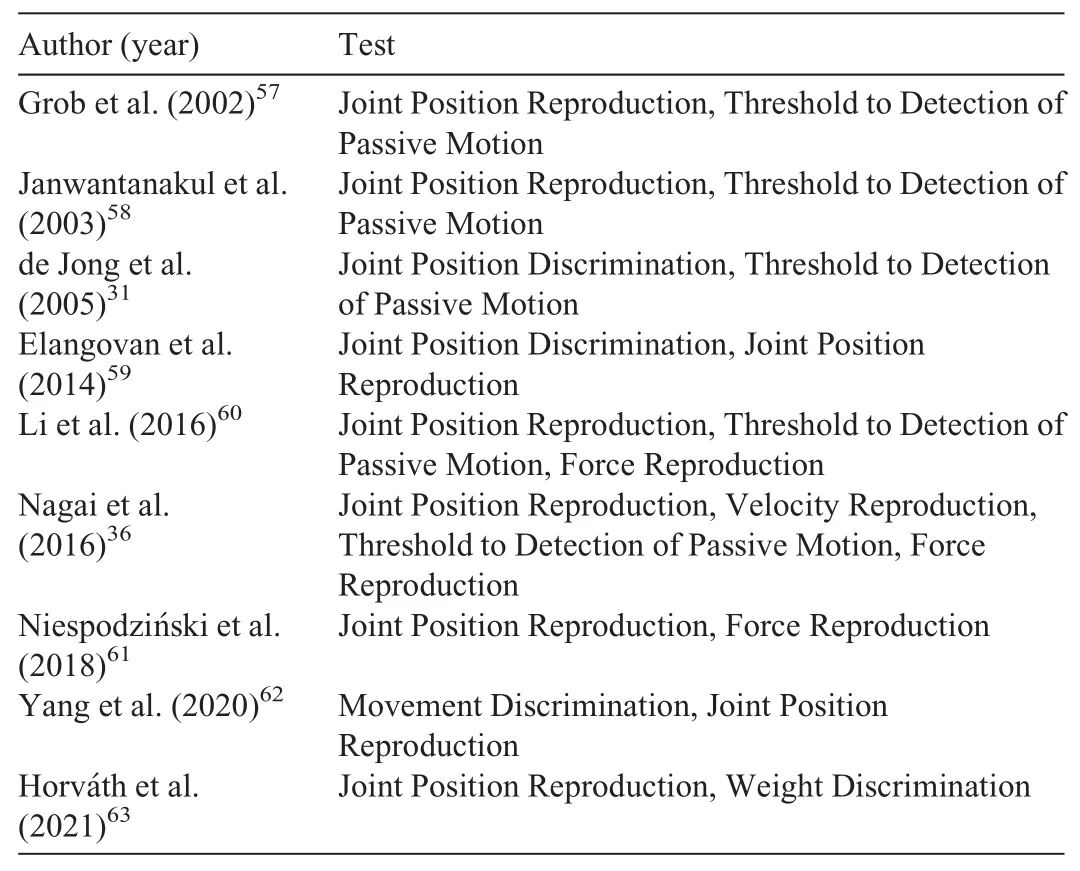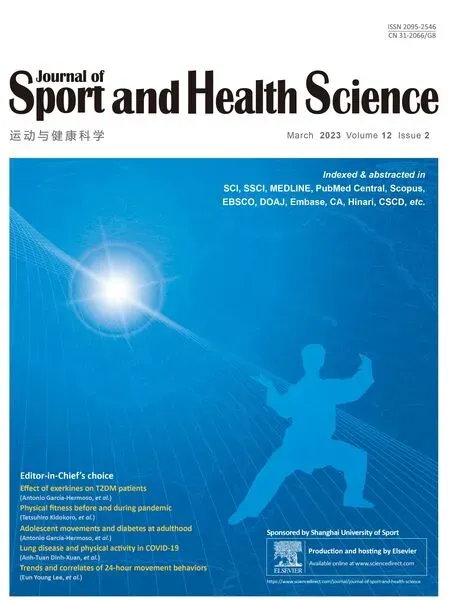The measurement of proprioceptive accuracy:A systematic literature review
Áron Horváth,Eszter Ferentzi,Kristóf Shwartza,,Nina Jaos,Pieter Meyns,Feren Köteles
a Doctoral School of Psychology,ELTE Eötvös Loránd University,Kazinczy street 23-27,Budapest 1075,Hungary
b Institute of Health Promotion and Sport Sciences,ELTE Eötvös Loránd University,Prielle Kornélia Street 47-49,Budapest 1117,Hungary
c Rehabilitation Research(REVAL),Faculty of Rehabilitation Sciences,University of Hasselt,Martelarenlaan 42,Hasselt 3500,Belgium
Abstract Background:Proprioceptive accuracy refers to the individual’s ability to perceive proprioceptive information,that is,the information referring to the actual state of the locomotor system,which originates from mechanoreceptors located in various parts of the locomotor system and from tactile receptors located in the skin.Proprioceptive accuracy appears to be an important aspect in the evaluation of sensorimotor functioning;however,no widely accepted standard assessment exists.In this systematic review,our goal was to identify and categorize different methods that are used to assess different aspects of proprioceptive accuracy.Methods:A literature search was conducted in 5 different databases(PubMed,SPORTDiscus,PsycINFO,ScienceDirect,and SpringerLink).Results:Overall,1139 scientific papers reporting 1346 methods were included in this review.The methods assess 8 different aspects of proprioception:(a)the perception of joint position,(b)movement and movement extent,(c)trajectory,(d)velocity,and the sense of(e)force,(f)muscle tension,(g)weight,and(h)size.They apply various paradigms of psychophysics(i.e.,the method of adjustment,constant stimuli,and limits).Conclusion:As the outcomes of different tasks with respect to various body parts show no associations(i.e.,proprioceptive accuracy is characterized by site-specificity and method-specificity),the appropriate measurement method for the task needs to be chosen based on theoretical considerations and/or ecological validity.
Keywords: Assessment;Kinesthesia;Motor control;Proprioception;Proprioceptive accuracy
1. Introduction
Optimal motor control requires proprioceptive information,which originates from mechanoreceptors located within the locomotor system.1To experience proprioception,the brain processes input from proprioceptors(i.e.,muscle spindles,which are located in the muscle belly and process information about the length and rate of stretch,and Golgi tendon organs,which pass on information about tension and,consequently,the force of contraction)and mechanoreceptors (i.e., Pacinian, Ruffini, Merkel, and Meissner corpuscle end-organs)located in the skin and ligaments as well as in joint capsules.2Moreover,not only afferent but efferent signals(i.e.,efference copy of the motor command,sense of effort)contribute to the sensation.2Normally developed humans are able to automatically process, integrate, and consciously perceive force,effort,weight and their body position,movement,and muscle tension based on this type of(proprioceptive)information3and use it for goal-oriented motor behavior.4
Proprioceptive accuracy refers to the individual’s ability to perceive proprioceptive information.5,6This ability is associated with important aspects of motor control and performance.For example,proprioceptive accuracy is positively associated with sport achievement in elite athletes.7Moreover, better proprioceptive accuracy in the elbow joint was found to be related to better throwing performance in basketball,8darts,9and water-polo.10Concerning the negative aspects,worse proprioceptive accuracy predicts a higher chance of getting injured;11also,as proprioceptive accuracy deteriorates with aging,5it may contribute to an increased risk of falls.12It has also been shown that physically active individuals are characterized by better proprioceptive accuracy, and physical activity can compensate for the negative impact of aging on proprioceptive accuracy.13Proprioceptive training(i.e.,“an intervention that targets the improvement of proprioceptive function”, (p2)14often including proprioceptive accuracy)is an efficient method to prevent injuries and improve motor performance.14
Based on the aforementioned associations,proprioceptive accuracy appears to be an important characteristic in the evaluation of sensorimotor functioning, for example, for sport selection7or for assessing the risk of injury and falls.11,15-17Also, measuring the change in proprioceptive accuracy is often used to evaluate the effectiveness of different interventions,for example,various surgical outcomes,18rehabilitation,19and warming-up20techniques.
There is a wide variety of methods that have been developed to measure various aspects of proprioceptive accuracy.Hillier and colleagues21identified 3 clusters of methods: joint position detection, passive motion detection, and passive motion direction discrimination.Starting from a different point of view,Han and colleagues6described 3 paradigms based on the classical methods developed for psychophysical experiments:22(a) joint position reproduction test, based on the method of adjustment, that is, participants have to adjust the level of a stimulus to a reference; (b) active movement extent discrimination assessment, based on the method of constant stimuli,that is,the stimuli are presented in pairings,and participants have to compare them;and(c)threshold to detection of passive motion,based on the method of limits,that is,participants have to indicate when they perceive the appearance or disappearance of a stimulus.6,22An important limitation of these reviews is their relatively narrow definition of proprioception. Han and colleagues6defined proprioceptive accuracy as“an individual’s ability to integrate the sensory signals from mechanoreceptors to thereby determine body segment positions and movements in space” (p81).6This account does not take into consideration certain important aspects of proprioception,such as the perception of heaviness,force,and muscle tension.2Similarly,the review of Hillier and colleagues21also included only a narrow range of methods, namely: joint position detection,passive motion detection threshold,and passive motion direction detection. Our recent review applies a more inclusive approach to proprioception than the previous papers.6,21A new review is also reasonable because of the growing literature on proprioception and the need to cover new tests developed since the publication of previous reviews.
The primary goal of the present systematic review was to identify and categorize the methods developed and used to measure proprioceptive accuracy in a comprehensive way by taking into consideration all important aspects of proprioception (i.e., sense of joint position, movement and movement extent,force,and heaviness).In doing this,this paper will help practitioners and researchers to find the method that best suits their needs for the assessment of proprioceptive accuracy.
2. Methods
The study was registered at PROSPERO Measurement of proprioceptive accuracy: a systematic literature review(CRD42020209136).While conducting this review,we followed the recommendations of the Preferred Reporting Items for Systematic Reviews and Metal-Analysis (PRISMA) statement.23Search strategy characteristics and study inclusion/exclusioncriteria are reported in Table 1. The abstracts and titles of the articles were searched in 5 different databases (PubMed,SPORTDiscus, PsycINFO, ScienceDirect, and SpringerLink),including every available article(i.e.,not only free text articles),without a restriction to publication date. The search was conducted on November 11, 2020. Proprioceptive accuracy was defined as the acuity of perception of proprioceptive information,that is,the information referring to the actual state of the locomotor system. It includes the processing of input from proprioceptors located in various parts of the locomotor system and from tactile receptors on the skin.It does not include visual and vestibular information.To decide on inclusion,2 independent authors(KS and ÁH)read the titles and abstracts of the papers as a first step. An article was excluded in this step only if both authors deemed it ineligible. In the next step, ÁH read the full text articles and made the final decision on inclusion.In case of any ambiguity,FK and EF decided on the inclusion of the article.

Table 1 Characteristics of the literature search.
3. Results
3.1. Included studies
Overall,6378 articles were identified in the database research.After removing the duplicates,4293 remained.After reading the titles/abstracts, a further 2332 articles were excluded because they did not meet the inclusion criteria.Based on the full texts of the remaining 1961 articles,a further 822 studies were excluded.In total,1139 studies were included in the review.Following this,1346 proprioceptive accuracy measurements were identified in a total of 1139 papers (Fig. 1); in a number of papers, multiple methods for the assessment of proprioceptive accuracy were used in the same sample. After that, measurement techniques were clustered based on their approach to measurement(Table 2).We used 2 main criteria to categorize the methods: what aspect of proprioceptive accuracy was assessed and what psychophysical approach was applied, which could be (a) the method of adjustment,where participants have to adjust the level of a stimulus to a reference; (b) the constant methods, which include both the method of constant stimuli,where participants have to judge standard and comparison stimuli presented in pairings, and the method of single stimuli,where participants judge a single stimulus presented alone; or (c) the method of limits, where participants have to indicate the appearance or disappearance of a stimulus. The full list of included articles is available at: https://osf.io/8f2zn/.

Table 2 Summary table of the proprioceptive accuracy measurement techniques.

Fig.1. Selection process of the articles,based on Moher and colleagues.64
3.2. Proprioceptive accuracy measurement techniques
3.2.1. Method of adjustment
Eight different types of proprioceptive accuracy measurements using the method of adjustment were identified.
Joint Position Reproduction (n=836). Participants have 1 or more joints of their body moved to a target position.Then they are asked to reproduce the position of the joint(s)as accurately as possible. In different versions of this task,movement can be active or passive, and the reproduction may happen with the same or with the contralateral joint(see also the discussion).
Pointing to Proprioceptive Target(n=42).One of the body parts is set to a target position.One has to point or reach to the position of the body part as accurately as possible.
Movement Reproduction (n=21). One of the body parts is moved through a given trajectory, with a given velocity, to a given endpoint. Participants are required to reproduce the trajectory,the speed,and the endpoint of the movement as accurately as possible.
Trajectory Reproduction (n=2). A body part is moved along a given trajectory.Participants have to reproduce the trajectory of the movement. This can happen with the same or with the contralateral joint.
Velocity Reproduction (n=9). A body part is set to move with a given velocity.The task of the participant is to reproduce the speed with the same or with the contralateral body part.
Force Reproduction (n=76). The participant is guided to produce a certain level of force with a muscle or muscle group.After production, they have to reproduce the same force with the same or with the contralateral muscle.
Keep Force Level(n=6).Participants have to produce a given amount of(submaximal)force and keep it on the same level.
Muscle Tension Reproduction (n=1). The participant is asked to produce a given level of muscle tension with a muscle or muscle group. After the production, one has to reproduce the same level of muscle tension as accurately as possible.
3.2.2. Method of constant stimuli
Six different proprioceptive accuracy measurement types were identified that were based on the method of constant stimuli.
Joint Position Discrimination (n=81). Participants have to compare 2 joint positions and decide whether these were the same or different (Note: The Active Movement Extent Discrimination Apparatus,6which presented a single stimuli for judgement in each trial, was also categorized as a Joint Position Discrimination test).
Movement Discrimination (n=6). Participants have to compare 2 movements (with a given trajectory, velocity, and endpoint)and decide if these were the same or different.
Velocity Discrimination (n=8). Participants have to perform 2 movement velocities and decide if these were the same or different.
Force Discrimination(n=5).Participants have to produce a given level of force twice and decide if these were the same or different level of forces.
Weight Discrimination (n=19). Participants are presented with 2 objects and have to decide if these were of the same or different weight.
Size Discrimination (n=3). Participants are presented with 2 objects and have to decide if these were of the same or different size.
3.2.3. Method of limits
One widely used proprioceptive accuracy measurement technique using the method of limits was identified.
Threshold to Detection of Passive Motion (n=231). One body part of the participant is moved passively. The task is to give a signal as soon as the displacement is perceived.This paradigm is based on the ascending method of limits (i.e., the level of stimuli gradually increases until perceived), whereas we did not find any example of the descending method (i.e., level of stimulus gradually decreases until perceived)used to assess proprioceptive accuracy.
4. Discussion
In this review, we identified and categorized the existing methods used for the assessment of proprioceptive accuracy.Also, we identified 8 different aspects or “senses” of proprioception(Table 2):the ability to perceive(a)joint position,(b)movement and movement extent,(c)trajectory,and(d)velocity, the level of (e) force, (f) muscle tension, (g) weight, and(h) size of different objects based on proprioceptive information.These aspects can be measured with the classical methods of psychophysics, that is, the method of adjustment, the method of constant stimuli,and the method of limits.
Proprioceptive accuracy assessment can be operationalized by taking different approaches and different paradigms.A common misconception in the literature is that results obtained with the use of one particular method with respect to one particular body part(e.g.,joint,muscle)can be generalized.In other words,it is (often implicitly) assumed that a generalizable proprioceptive accuracy exists and that each test measures this general ability. If this would be the case, a strong association between results obtained with different tests for different body parts should exist.In other words,the best performers in one particular test(e.g.,Joint Position Reproduction)with respect to one particular body part(e.g.,elbow)would probably be the best performers in another test (e.g., Threshold to Detection of Passive Motion)assessing another body part(e.g.,knee).Empirical findings,however,do not support the existence of such a strong relationship. In fact, proprioceptive accuracy is characterized by both site-specificity and method-specificity.Table 3 summarizes the studies investigating the relationship between different tests;none of them reported a significant correlation.The existence of such a discordance is further supported by studies revealing testspecific differences in certain proprioceptive abilities.For example,Barrack and colleagues24found that dancers perform worse than controls in Joint Position Reproduction test but are better atThreshold to Detection of Passive Motion with respect to the proprioceptive accuracy of the knee joint. It was also reported that Force Reproduction test,but not Joint Position Reproduction test is related to ankle instability index25and ankle stiffness.26Another example is that deficits in motor functioning, such as walking disability, sensory disturbance, and central motor conduction time,were only associated with proprioceptive accuracy assessed with the Joint Position Reproduction test and not with that measured with the Threshold to Detection of Passive Motion test in compressive neuropathy.27Finally, experimentallyinduced pain influenced the outcome of the Threshold to Detection of Passive Motion test, but did not affect participants’ performance in the Joint Position Reproduction test.28

Table 3 Summary table of studies investigating the association between different tests of proprioceptive accuracy.None of the studies found a significant association.
Also, evidence shows that results with respect to one body part may not be generalized to others.With respect to the Joint Position Discrimination(AMEDA)test,there is a strong correlation between the same joints on the 2 body sides,but no association between different joints.29,30Moreover, lack of association can be observed in many cases within the same test and joint too.For example,no association was found between detection threshold when the limb is moved with different speeds.31Finally, results may be joint-position specific; for example,people with functional ankle instability showed position-specific deficits in a Joint Position Reproduction task.32
Another consideration is related to the question of how performance in the tests should be scored. Most of the methods allow the use of many performance scores.For example,for the method of adjustment,absolute error refers to the mean absolute difference between the reference and the reproduced stimuli, constant error refers to the signed difference(indicating systematic bias in judgements), and variable error refers to the standard deviation of the error score (indicating dispersion around the constant error).33-35In a similar vein, the method of constant stimuli allows the use of the sensitivity (proportion of correct judgements when the 2 stimuli differ) and specificity (proportion of correct judgements when the 2 stimuli are the same) indices, and the Just Noticeable Difference (the lowest level of difference that one can detect, for example, at least 50% of the time). There is no clear agreement in the literature how these tests should be scored; even the correlation between the various indices is rarely reported. From a more practical point of view, the use of multiple indices often makes the comparison of findings of various studies impossible.
Altogether, these issues (i.e., test- and site-specificity and the lack of agreement on how tests should be scored)imply that when using the term proprioceptive accuracy, the test used, the score used to evaluate the test,and the joint measured always need to be specified. As proprioceptive accuracy is not a general ability, it cannot be assessed with the use of a single test,31and so one should always choose a method that best suits the research or practical question at hand.36For researchers,an important task for the future is to find the best method to measure proprioceptive accuracy.One important consideration is ecological validity, for example, how well different tests reflect the effects of injury and expertise.37,38
Moreover, there are other important factors that should be taken into consideration when choosing the appropriate test.Some tests inherently require active effort from the participants(e.g.,force reproduction and discrimination,muscle tension reproduction,weight discrimination),but in other cases(e.g.,joint position reproduction) the test can be based on passive movement only. For certain patient groups with movement disorders, only the passive movement versions are applicable. Because of the tight interaction between the input and output aspects of motor control,39,40active motion involves the processing of both afferent(e.g., the feedback from muscle spindles) and efferent (i.e., the efference copy of motor command) signals. Therefore, people tend to be more accurate when active muscle activity increases,for example,by allowing active motion41or by increasing shoulder elevation angle42and weight bearing.43Weight bearing can also compensate for the negative effect of experimentally induced joint effusion.44From the viewpoint of external(ecological)validity, tests that involve active motion should be preferred, as they better reflect the individual’s performance under everyday circumstances. Important for the choice of an appropriate test is that some patients with movement disorders may not be able to move the limb or joint up to a specific position even though it may have been possible passively(e.g.,the affected upper or lower limb in patients with unilateral stroke),which will affect the results of the proprioceptive accuracy test dramatically. As such, it has to be considered whether the reproduction/comparison happens with the ipsilateral or with the contralateral joint.The ipsilateral version requires memory while the contralateral version requires interhemispheric transfer,5so in patients with significant memory impairment,the ipsilateral version is not preferred.In other words,additional abilities and features beyond the processing of proprioceptive signal(s) can substantially impact performance. Another important factor that can influence the outcome of the assessment is the measured body side,as there might be differences between the dominant and subdominant limb in the processing of proprioceptive information.29,45-48
The approach to proprioception and proprioceptive accuracy used in this systematic review paper is broader than that of previous literature reviews.6,21This enabled us to explore methods not included in those reviews. It is worth noting that our definition excluded signals that do not originate in the locomotor system or the skin (and related efferent signals) but that might play an important role in the perception of our body, most importantly the visual modality. Also, because of the definition used, only methods of assessment that require the subject to consciously be aware of proprioceptive information were included. These factors may limit the ecological validity of proprioceptive accuracy tests. To reach cognitive perception of proprioceptive accuracy,proprioceptive and related somatosensory signals are processed through the conscious relay pathways(i.e.,dorsal column/medial lemniscus system).49However, in activities of daily life,movement regulation is a dominantly non-conscious(automatic)process that does not require conscious perception of proprioceptive signals.50Proprioceptive information that does not reach conscious awareness is forwarded through the spinal reflex pathway or the spinocerebellar tract to contribute to automatic postural adjustments and balance control.51As indicated by previous neuro-imaging research,central processing of ankle proprioception can predict balance performance in younger and older adults.52In other words, ankle proprioception will provide important non-conscious feedback regarding body sway, which is crucial for restoring or maintaining a state of balance.Hence,some researchers incorporate“sense of balance”in the definition of proprioception.3Following this logic, a balance task can be used as an alternative method to(indirectly)assess the functional ability to use non-conscious proprioception (to keep a state of balance), especially in situations where visual information is eliminated (i.e., where participants are blindfolded).53In this way, some researchers attribute increased postural sway (e.g.,Romberg test)to loss of proprioceptive sensation.54However,it is important to note that balance control is a complex process depending on multiple sensorimotor mechanisms.55So, in this way, it can be stated that an increment in postural sway cannot be attributed exclusively to a reduction in proprioceptive information as other sensory feedback systems can play an important role as well(e.g.,the vestibular system and other somatosensory senses,such as plantar cutaneous foot sensation),not to speak of the required motor functions.
This review is not without shortcomings. A single author made the decision about the final inclusion of the articles at the full-text stage, which could lead to biased selection. Also,articles reporting methods that contain the search terms may be overrepresented.
To choose the appropriate method to measure proprioceptive accuracy,the first step is to decide which aspect of proprioception one wants to assess:the sense of joint position,trajectory,speed,movement and movement extent, force, muscle tension, weight,or size. For researchers, theoretical consideration may guide this decision, while for practitioners, ecological validity may be the most important factor. It is important to consider whether a passive test,where participants do not have to conduct active movement or effort,or an active test is more appropriate.In the former case,afferent sensory signals play a more dominant role,while in the latter case,efferent signals also contribute to perception.However, it is also important to note that these systems (afferent and efferent)may not be completely separable.39,40In specific patient populations,researchers and practitioners should take into account the motor capacity, range of motion, and muscle strength of the limb or joint of interest and adapt the test to the needs of the patient.Additionally,in patients with severe memory impairment,a contralateral version is recommended. Different aspects can be measured with the method of adjustment, method of constant stimuli, or with the method of limits.6,22Besides the decision regarding the measurement method, the relevant joint and body side should be measured with an appropriate stimulus intensity (i.e., joint position, speed, trajectory, force,contraction level, weight, or size). Importantly, one should be aware that proprioceptive accuracy is body site- and testspecific, meaning that results obtained with a given test are not generalizable for other tests nor for other joints.Accuracy might also be specific to the target stimuli (e.g.,speed of motion, target joint position). Better understanding of the benefits and shortcomings of different paradigms can also be helpful in the development of novel tests meant to assess new aspects of proprioception. For example, the loss of proprioceptive accuracy over long-duration spaceflights to Macaulay et al.56suggests that astronauts with good initial proprioceptive acuity should be selected for the journey. An important practical question is, however, how their proprioceptive accuracy should be measured.
Acknowledgments
Áron Horváth was supported by the ′UNKP-20-3 New National Excellence Program of the Ministry for Innovation and Technology from the source of the National Research,Development and Innovation Fund (′UNKP-20-3-II-ELTE-163). Nina Jacobs was supported by the Fonds voor Wetenschappelijk Onderzoek-Vlaanderen (FWO) Research Foundation Flanders (11M2622N)and the Special Research Fund(Het Bijzonder Onderzoeksfonds,BOF)of Hasselt University(BOF19KP08).
Authors’contributions
ÁH took part in designing the study, in selection process,and wrote the first draft of the manuscript; EF took part in designing the study; KS took part in the selection process; NJ wrote sections of the manuscript; PM wrote sections of the manuscript;FK took part in designing the study and wrote sections of manuscript. All authors have read and approved the final version of the manuscript,and agree with the order of presentation of the authors.
Competing interests
The authors declare that they have no competing interests.
 Journal of Sport and Health Science2023年2期
Journal of Sport and Health Science2023年2期
- Journal of Sport and Health Science的其它文章
- Exercise training-induced changes in exerkine concentrations may be relevant to the metabolic control of type 2 diabetes mellitus patients:A systematic review and meta-analysis of randomized controlled trials
- Stair climbing,genetic predisposition,and the risk of incident type 2 diabetes:A large population-based prospective cohort study
- Twenty-four-hour movement guidelines during middle adolescence and their association with glucose outcomes and type 2 diabetes mellitus in adulthood
- The effects of a 20-week exercise program on blood-circulating biomarkers related to brain health in overweight or obese children:The ActiveBrains project
- Dose-dependent associations of joint aerobic and muscle-strengthening exercise with obesity:A cross-sectional study of 280,605 adults
- Chronotropic incompetence is more frequent in obese adolescents and relates to systemic inflammation and exercise intolerance
